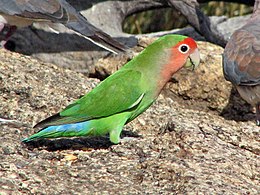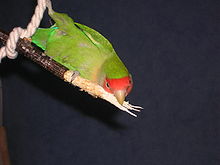Rosy-faced lovebird
| Rosy-faced lovebird | |
|---|---|

| |
| In Namibia, Africa | |
| Scientific classification | |
| Domain: | Eukaryota |
| Kingdom: | Animalia |
| Phylum: | Chordata |
| Class: | Aves |
| Order: | Psittaciformes |
| Family: | Psittaculidae |
| Genus: | Agapornis |
| Species: | A. roseicollis
|
| Binomial name | |
| Agapornis roseicollis (Vieillot, 1818)
| |

| |
| Native ranges in the Namib Desert and arid areas of Namibia and Angola | |
The rosy-faced lovebird (Agapornis roseicollis), also known as the rosy-collared or peach-faced lovebird, is a species of lovebird native to arid regions in southwestern Africa such as the Namib Desert. A loud and constant chirper, these birds are very social animals and often congregate in small groups in the wild. They eat throughout the day and take frequent baths. Coloration can vary widely among populations. Plumage is identical in males and females. Lovebirds are renowned for their sleep position in which they sit side-by-side and turn their faces in towards each other. Also, females are well noted to tear raw materials into long strips, "twisty-tie" them onto their backs, and fly substantial distances back to make a nest. They are common in the pet industry, although lovebirds are often not hand-raised.
Taxonomy
It was described by the French ornithologist Louis Jean Pierre Vieillot in 1818. It was originally named Psittacus roseicollis but later moved to the genus Agapornis with the other lovebirds.
Two subspecies are recognised:[2]
- Agapornis roseicollis, (Vieillot, 1818)
Description

The rosy-faced lovebird is a fairly small bird, 17–18 cm long with an average wing length of 106 mm and tail length of 44–52 mm.[4] Wild birds are mostly green with a blue rump. The face and throat are pink, darkest on the forehead and above the eye. The bill is horn coloured, the iris is brown and the legs and feet are grey. The pink of the A. r. roseicollis is lighter than of the A. r. catumbella.[3] Juvenile birds have a pale pink face and throat, a greenish fore crown and crown, and the beak has a brownish base.[3]
Distribution and habitat
It inhabits dry, open country in southwest Africa. Its range extends from southwest Angola across most of Namibia to the lower Orange River valley in northwest South Africa. It lives up to 1,600 metres above sea-level in broad-leaved woodland, semi-desert, and mountainous areas. It is dependent on the presence of water sources and gathers around pools to drink.
Escapes from captivity are frequent in many parts of the world and feral birds dwell in metropolitan Phoenix, Arizona, where they live in a variety of habitats, both urban and rural. Some dwell in cacti and others have been known to frequent feeders in decent sized flocks.[5]
Status and conservation
Populations have been reduced in some areas by trapping for the pet trade. However, numbers may have increased in other areas due to human creation of new water sources and the building of artificial structures which provide new nesting sites. Because of this, the species is classed as Least Concern by the International Union for Conservation of Nature (IUCN).[1]
Behaviour in the wild

The rosy-faced lovebird has various harsh, shrieking calls.
Feeding
The diet mainly consists of seeds and berries. When food is plentiful, it may gather in flocks containing hundreds of birds. It can sometimes be a pest in agricultural areas feeding on crops such as millet.
Breeding



Finding a pair of these birds for breeding is not easy because their sex is not easily determined. The sex can be determined by the distance between the pelvis bones which in males measures 1–3 mm while measuring 6–8 mm in females.[6] The nest is built in a rock crevice or within a compartment of the large communal nests built by sociable weavers. Man-made structures such as the roofs of houses may also be used. 4-6 eggs are laid between February and April. They are dull white and measure 23.5 mm by 17.3 mm. They are incubated for about 23 days. The young birds fledge after 43 days.[4]
Aviculture

Rosy-faced lovebirds are one of the more common parrots kept in captivity, because of their small size and ease of care and breeding. The birds are kept alone or in pairs, although they are often aggressive, and tend to bond towards an individual, either human or avian, and may not get on well with other people or pets. Two lovebirds may not always get along, and may have to be separated.


Mutations
Rosy-faced lovebirds have the widest range of colour mutations of all the Agapornis species. Generally speaking, these mutations fall into the genetic categories of dominant, codominant, recessive, and X-linked recessive. While this seems fairly straightforward, it can quickly become confusing when a single specimen has multiple examples of these mutational traits.
- Colour varieties in aviculture
-
Wild type
-
Left: Wild type
Right: Lutino mutation -
Left: Wild type
Right: Pied Green mutation -
Aqua Turquoise mutation
-
Left: Pied mutation
Center: Hybrid of peach-face and a fischeri
Right: Orange-face mutation -
Turquoise mutation
-
Green Single Violet factor Opaline mutation
-
They can be tamed
-
Opaline Double Dark factor mutation
References
- ^ a b Template:IUCN
- ^ "Zoological Nomenclature Resource: Psittaciformes (Version 9.004)". www.zoonomen.net. 2008-07-05.
- ^ a b c d Forshaw (2006). plate 45.
- ^ a b McLachlan G. R. & Liversidge, R. (1981) Roberts Birds of South Africa, John Voelcker Bird Book Fund, Cape Town. ISBN 0-620-03118-2
- ^ Clark, Greg. "Peach-faced Lovebird Range Expansion Data in Greater Phoenix, Arizona Area". Retrieved 2011-02-27.
- ^ "Peach Faced Lovebird info". parrot-bird.com. Retrieved 30 June 2010.
- "Species factsheet: Agapornis roseicollis". BirdLife International (2008). Retrieved 9 July 2008.
- Luft, Stefan|Luft, Stefan (2007): Parrots of Africa (1st edition). Halberstadt, Germany. ISBN 978-3-8334-8445-2
- eBird.org (2011)
Cited texts
- Forshaw, Joseph M. (2006). Parrots of the World; an Identification Guide. Illustrated by Frank Knight. Princeton University Press. ISBN 0-691-09251-6.
{{cite book}}: Unknown parameter|nopp=ignored (|no-pp=suggested) (help)
External links
- Peach Faced Lovebird mutation information Information on PFLB mutations
- Peach-faced Lovebird Range Expansion Data in Greater Phoenix, Arizona
- African Love Bird Society An international organization dedicated to the keeping, breeding, and showing of Love Birds.
- Rosy-faced lovebird - Species text in The Atlas of Southern African Birds.










